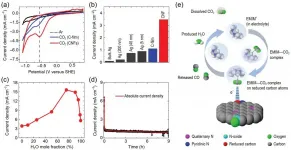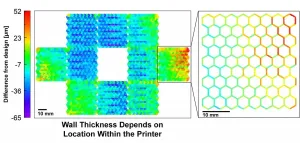(Press-News.org) The use of fossil fuels as energy carriers and raw materials promotes the rapid development of the society. However, the excessive exploitation of fossil fuels gives rise to the energy crisis and undesirable environmental changes. In particular, a continuous increase of CO2 concentration in the atmosphere, which is > 400 ppm today and is estimated to triple by 2040, might result in a series of environmental issues, such as global warming, rising sea levels, and more extreme weather. Therefore, cutting CO2 emissions and developing abundant renewable energy are urgent needs and challenges for our society.
CO2 is not only one of the main greenhouse gases but also an abundant, nontoxic, nonflammable, and renewable C1 resource. Electrochemical conversion of CO2 is an attractive way to recycle CO2 into value-added products and make it possible to store electrical energy in chemical form. As an important component in the electrocatalysis process, the electrolyte interacts with the electrode surfaces, reactants, and intermediates, which plays a key role in charge transport. Different electrolytes have been explored to promote the development of CO2 electrochemical conversion technology.
Ionic liquids (ILs) are organic salts composed of cations and anions with the melting point below 100 ?. Many of them are liquids even at room temperature. ILs have been demonstrated to be the very promising candidate electrolytes for the electrochemical conversion of CO2 due to their unique structural features and physical properties, e.g., high absorption capacity of CO2, high intrinsic ionic conductivity, and wide electrochemical potential widows.
In a new overview published in the Beijing-based National Science Review, scientists at the Institute of Chemistry, Chinese Academy of Sciences in Beijing, China present the latest advances in electrochemical transformation of CO2 into value-added chemicals in IL-based electrolytes. Co-authors Xingxing Tan, Xiaofu Sun, and Buxing Han trace the history of the development of CO2 electrochemical transformation in IL-based electrolytes; they also review representative ILs system, electrocatalysts, and reactor configurations used in CO2 electrochemical transformation.
These scientists likewise outline the potential development directions of IL-based electrolytes for CO2 electrochemical transformation.
"Typically, CO2 electroreduction (CO2ER) and CO2 electroorganic transformation (CO2EOT) are two important routes to convert CO2 into value-added carbonic fuels and chemicals. CO2 electroreduction represents an essential approach for CO2 utilization, in which CO2 could be transformed into many platform chemicals through the construction of C-H bond, such as hydrocarbons, acids, and alcohols. In addition, CO2 can be used as one of the reactants to react with different substrates (e.g., alkenes, alkynes, ketones, epoxides, aziridines, or propargylic amines) to synthesize carboxylic acids, cyclic carbonates, and oxazolidinone derivatives through the construction of C-C, C-O, or C-N bonds," they state in an article titled "Ionic Liquid-Based Electrolytes for CO2 Electroreduction and CO2 Electroorganic Transformation."
"The typical system for CO2ER consists of anode and cathode compartments separated by a proton exchange membrane. Both CO2 reduction reaction and HER take place at the cathode driven by electric energy over the catalyst. CO2EOT is usually performed in undivided cells," they add. "The electrolyte undertakes the role of transporting charge species. Studies have demonstrated that ILs could reduce the initial barrier of CO2 conversion through lowering the formation energy of CO2* - intermediate. Moreover, the competing hydrogen evolution reaction (HER) could be suppressed in the presence of ILs, which might be favorable to improving the selectivity of CO2 conversion."
Syngas was obtained by electrolyzing supercritical CO2 and water in 1-butyl-3-methylimidazolium hexafluorophosphate ([Bmim]PF6) electrolyte in 2004. The reduction of CO2 to CO with a Faradaic efficiency (FE) of 96% was achieved in an electrocatalytic system with Ag cathode and 18 mol % 1-ethyl-3-methylimidazolium tetrafluoroborate ([Emim]BF4) solution electrolyte in 2011, which was marked as an important breakthrough in the development of IL electrolytes for CO2ER.
DMC is almost the most studied product of CO2EOT that involve the use of ILs. "Electrocatalytic fixation of CO2 to epoxides or alcohols to yield organic carbonates via C-O bond formation can avoid the use of toxic phosgene or CO, providing a green and atom economy pathway for the synthesis of organic carbonates," they state.
"Further improvement in the performance of electrochemical conversion of CO2 can be achieved by designing novel functional IL-based electrolytes and exploring innovative electrocatalysts and optimized electrode/reactor configurations. It will also be of great significance to use CO2 as C1 synthon to prepare more diverse chemicals by the construction of different kinds of C-X bonds, like C-Si, C-P, C-S bonds," the scientists forecast.
"The current advancement of electrochemical transformation of CO2 should address the large overpotential, low current density, unsatisfactory product selectivity and yield urgent, especially for value-added C2+ products," they add. "ILs are considered to offer great potential for CO2 conversion technology. Electrochemical transformation of CO2 in IL-based electrolyte is expected to integrate CO2 fixation with renewable electricity storage, providing an avenue to close the anthropogenic carbon cycle."
INFORMATION:
This research received funding from the National Key Research and Development Program of China, National Natural Science Foundation of China, Beijing Municipal Science & Technology Commission, and the Chinese Academy of Sciences.
See the article:
Xingxing Tan, Xiaofu Sun, and Buxing Han
Ionic liquid-based electrolytes for CO2 electroreduction and CO2 electroorganic transformation
Natl Sci Rev nwab022
https://doi.org/10.1093/nsr/nwab022
According to a new study published in the Journal of the Royal Society of Medicine, the carbon footprint of personal protective equipment (PPE) provided to health and social care staff in England during the first six months of the COVID-19 pandemic was equivalent to flying from London to New York 244 times every day. The good news is that adopting a range of strategies including increased UK manufacture, reusing and recycling could reduce the environmental impact of PPE dramatically while maintaining the safety of staff and patients.
The study, by Brighton and Sussex Medical School and Brighton and Sussex University Hospitals NHS Trust, found that the 3 billion items of PPE used from ...
Precision or invar alloys have been developed by scientists for many centuries. These iron and nickel-based alloys are capable of keeping their size unchanged within a given range of temperatures. Because of this, they are used in the manufacture of precision gages, standards of length, details for mechanical dial plates, and similar devices. However, invar alloys lack many other useful physical characteristics, and this limits their use in other areas, for example, those that require high thermal conductivity of materials. Therefore, scientists have long been trying to create a unique composite material based on other metals ...
Connections are crucial. Bacteria may be most dangerous when they connect - banding together to build fortress-like structures known as biofilms that afford them resistance to antibiotics. But a biomolecular scientist in Israel and a microbiologist in California have forged their own connections that could lead to new protocols for laying siege to biofilm-protected colonies. Their research was published in the Proceedings of the National Academy of Sciences (PNAS), USA.
This interdisciplinary collaboration began with a lecture given at the Weizmann Institute of Science in the Life Sciences Colloquium. Prof. Dianne Newman of the California Institute of Technology was the speaker, ...
A research breakthrough shows that a simple blood test could reduce, or in some cases replace, the need for intrusive surgery when determining the best course of treatment for patients with a specific type of brain tumour.
Researchers at the Brain Tumour Research Centre of Excellence at the University of Plymouth have discovered a biomarker which helps to distinguish whether meningioma - the most common form of adult primary brain tumour - is grade I or grade II.
The grading is significant because lower grade tumours can sometimes remain dormant for long periods, not requiring high risk surgery or harsh treatments such as radiotherapy and chemotherapy. Tumours classified as grade II can progress to become cancerous and more aggressive treatment may be needed in order ...
Many athletes, from football players to equestrians, rely on helmets to protect their heads from impacts or falls. However, a loose or improperly fitted helmet could leave them vulnerable to traumatic brain injuries (TBIs), a leading cause of death or disability in the U.S. Now, researchers reporting in ACS Sensors have developed a highly sensitive pressure sensor cap that, when worn under a helmet, could help reveal whether the headgear is a perfect fit.
According to the U.S. Centers for Disease Control and Prevention, 1.6 to 3.8 million sports- and recreation-related TBIs occur each year in the U.S. Field data suggest that loose or improperly fitted helmets can contribute ...
March 17, 2021-- A new study published online in the Annals of the American Thoracic Society reveals how socioeconomic factors partially explain the increased odds that Black and Hispanic Americans have of testing positive for SARS-CoV-2, the virus that causes COVID-19.
In "Association of Race and Ethnicity With COVID-19 Test Positivity and Hospitalization Is Mediated by Socioeconomic Factors," Hayley B. Gershengorn, MD, associate professor, Division of Pulmonary, Critical Care and Sleep Medicine, University of Miami Miller School of Medicine and co-authors ...
Scientists at Sanford Burnham Prebys Medical Discovery Institute demonstrated for the first time that blocking "cell drinking," or macropinocytosis, in the thick tissue surrounding a pancreatic tumor slowed tumor growth--providing more evidence that macropinocytosis is a driver of pancreatic cancer growth and is an important therapeutic target. The study was published in Cancer Discovery, a journal of the American Association for Cancer Research.
"Now that we know that macropinocytosis is 'revved up' in both pancreatic cancer cells and the surrounding fibrotic tissue, blocking the process might provide a 'double whammy' to pancreatic tumors," ...
Researchers at University of Illinois Urbana-Champaign developed software to improve the accuracy of 3D-printed parts, seeking to reduce costs and waste for companies using additive manufacturing to mass produce parts in factories.
"Additive manufacturing is incredibly exciting and offers tremendous benefits, but consistency and accuracy on mass-produced 3D-printed parts can be an issue. As with any production technology, parts built should be as close to identical as possible, whether it is 10 parts or 10 million," said Professor Bill King, Andersen Chair in the Department of Mechanical Science and Engineering and leader of the project.
The team's ...
- The increasing complexity of treatments for lung cancer and language differences can make it difficult for patients to communicate with their medical teams
- Risks of jeopardising the treatment and care journey as well as recent progress in patient empowerment.
Lugano, Switzerland; Denver, CO, USA, 17 March 2021 - More than one in 10 patients with lung cancer do not know what type of tumour they have, according to data from a 17-country study carried out by the Global Lung Cancer Coalition (GLCC) to be presented at the European Lung Cancer Conference (ELCC) ...
What would a volcano - and its lava flows - look like on a planetary body made primarily of metal? A pilot study from North Carolina State University offers insights into ferrovolcanism that could help scientists interpret landscape features on other worlds.
Volcanoes form when magma, which consists of the partially molten solids beneath a planet's surface, erupts. On Earth, that magma is mostly molten rock, composed largely of silica. But not every planetary body is made of rock - some can be primarily icy or even metallic.
"Cryovolcanism is volcanic activity on icy worlds, and we've seen it happen on Saturn's moon Enceladus," says Arianna Soldati, assistant professor of marine, earth and atmospheric sciences at NC State and lead author of a paper describing the ...







